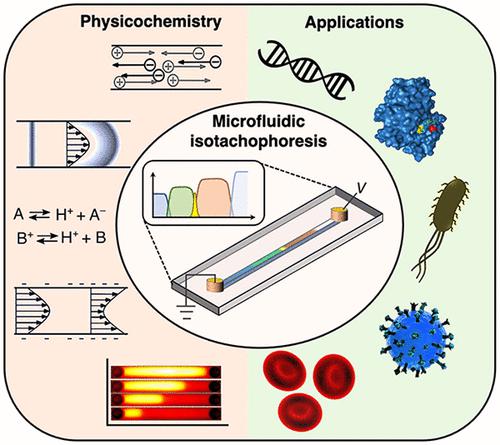当前位置:
X-MOL 学术
›
Chem. Rev.
›
论文详情
Our official English website, www.x-mol.net, welcomes your feedback! (Note: you will need to create a separate account there.)
Isotachophoresis: Theory and Microfluidic Applications
Chemical Reviews ( IF 62.1 ) Pub Date : 2022-06-22 , DOI: 10.1021/acs.chemrev.1c00640 Ashwin Ramachandran 1 , Juan G Santiago 2
Chemical Reviews ( IF 62.1 ) Pub Date : 2022-06-22 , DOI: 10.1021/acs.chemrev.1c00640 Ashwin Ramachandran 1 , Juan G Santiago 2
Affiliation

|
Isotachophoresis (ITP) is a versatile electrophoretic technique that can be used for sample preconcentration, separation, purification, and mixing, and to control and accelerate chemical reactions. Although the basic technique is nearly a century old and widely used, there is a persistent need for an easily approachable, succinct, and rigorous review of ITP theory and analysis. This is important because the interest and adoption of the technique has grown over the last two decades, especially with its implementation in microfluidics and integration with on-chip chemical and biochemical assays. We here provide a review of ITP theory starting from physicochemical first-principles, including conservation of species, conservation of current, approximation of charge neutrality, pH equilibrium of weak electrolytes, and so-called regulating functions that govern transport dynamics, with a strong emphasis on steady and unsteady transport. We combine these generally applicable (to all types of ITP) theoretical discussions with applications of ITP in the field of microfluidic systems, particularly on-chip biochemical analyses. Our discussion includes principles that govern the ITP focusing of weak and strong electrolytes; ITP dynamics in peak and plateau modes; a review of simulation tools, experimental tools, and detection methods; applications of ITP for on-chip separations and trace analyte manipulation; and design considerations and challenges for microfluidic ITP systems. We conclude with remarks on possible future research directions. The intent of this review is to help make ITP analysis and design principles more accessible to the scientific and engineering communities and to provide a rigorous basis for the increased adoption of ITP in microfluidics.
中文翻译:

等速电泳:理论和微流体应用
等速电泳 (ITP) 是一种多功能电泳技术,可用于样品预浓缩、分离、纯化和混合,以及控制和加速化学反应。尽管这一基本技术已有近一个世纪的历史并被广泛使用,但人们始终需要对 ITP 理论和分析进行易于理解、简洁和严格的审查。这一点很重要,因为在过去的二十年里,人们对这项技术的兴趣和采用不断增长,特别是它在微流体中的应用以及与片上化学和生化分析的集成。我们在这里从物理化学第一原理出发对 ITP 理论进行回顾,包括物种守恒、电流守恒、电荷中性近似、弱电解质的 pH 平衡、以及所谓的控制运输动态的调节功能,特别强调稳定和不稳定的运输。我们将这些普遍适用(适用于所有类型的 ITP)的理论讨论与 ITP 在微流体系统领域的应用(特别是片上生化分析)结合起来。我们的讨论包括弱电解质和强电解质的 ITP 聚焦原则;峰值模式和平台模式下的 ITP 动态;对模拟工具、实验工具和检测方法的回顾;ITP 在片上分离和痕量分析物操作中的应用;以及微流控 ITP 系统的设计考虑因素和挑战。最后我们对未来可能的研究方向进行了评论。
更新日期:2022-06-22
中文翻译:

等速电泳:理论和微流体应用
等速电泳 (ITP) 是一种多功能电泳技术,可用于样品预浓缩、分离、纯化和混合,以及控制和加速化学反应。尽管这一基本技术已有近一个世纪的历史并被广泛使用,但人们始终需要对 ITP 理论和分析进行易于理解、简洁和严格的审查。这一点很重要,因为在过去的二十年里,人们对这项技术的兴趣和采用不断增长,特别是它在微流体中的应用以及与片上化学和生化分析的集成。我们在这里从物理化学第一原理出发对 ITP 理论进行回顾,包括物种守恒、电流守恒、电荷中性近似、弱电解质的 pH 平衡、以及所谓的控制运输动态的调节功能,特别强调稳定和不稳定的运输。我们将这些普遍适用(适用于所有类型的 ITP)的理论讨论与 ITP 在微流体系统领域的应用(特别是片上生化分析)结合起来。我们的讨论包括弱电解质和强电解质的 ITP 聚焦原则;峰值模式和平台模式下的 ITP 动态;对模拟工具、实验工具和检测方法的回顾;ITP 在片上分离和痕量分析物操作中的应用;以及微流控 ITP 系统的设计考虑因素和挑战。最后我们对未来可能的研究方向进行了评论。



























 京公网安备 11010802027423号
京公网安备 11010802027423号